| Music, Sound and Personalities: The 2002 WCES and T.H.E. Expo
by Dave Glackin
(this report first appeared at enjoythemusic.com, reprinted with
permission by the author)
2002. My eighteenth CES. No more surprises, right? Wrong.
Mike Maloney of The Home Entertainment Expo (T.H.E. Expo, the new
name for T.H.E. Show—www.the-expo.net) outdid
himself this year. Originally scheduled to be held across town from the CES show, at the
eleventh hour Mike was able to secure the Tuscany Hotel for T.H.E. Expo. This is the best
venue I have ever seen for an audio show. The standard rooms were big (450 sq ft of usable
space), and a 180-amp subpanel was in every room. It sure beat the bad old days
of the Sahara Bi-Level, where the power kept going off. So what if on the day of check-in,
the lobby was set up in one of the guest rooms, the switchboard was perched on a bed, and
the real lobby still had statues sitting on the floor? The rooms were acoustically great,
the grounds were beautiful, and it was wonderful to be able to walk right out of my room
and into the show. And they now reportedly have a world-class Italian restaurant on the
premises.
The CES portion of the high-end show was again held in the Alexis
Park, the best venue I have seen that show held in. It was great to be able to get out
into fresh air between the rooms, mentally wiggle my toes in the grass, and chat with old
friends by the pool. It’s a far cry from the bad old days of dim hallways at the
rat-warren Sahara. Here’s hoping this hotel stays in the CES playbook for many years.
But, acoustically and esthetically, the Tuscany has it beat.
The show was made all the better by being able to see it with my
partner in crime, Stan Ricker. Stan just seems to gravitate toward the good-sounding rooms
like a music-seeking missile. His storehouse of knowledge never ceases to amaze me, even
after interviewing him several years ago for nine hours and attending CES with him ever
since. He can dissect what’s wrong with a system without breaking a sweat.
Here’s to many more years of true friendship and fun, Stan. Oh, and as usual,
I’m only writing about the rooms that I liked. The sound quality in many more,
including some with very recognizable names, simply didn’t float my boat.
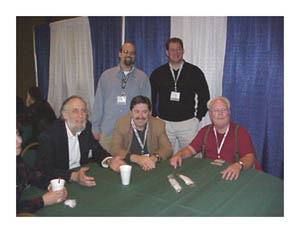
News Flash! It warms my heart to see that Mobile Fidelity (www.mofi.com) is being resurrected from the ashes of the
old company. The head of the new MoFi is also the head of Music Direct, Jim Davis. The
director of new technology for MoFi is John Wood. They plan to release 180 gram LPs, plus
CDs and SACDs, using the original studio in Sebastopol, California. You may have known all
that, but I’ll bet you didn’t know this: the new company will be hiring Stan
Ricker to do much of the LP mastering. Stan co-founded the original Mobile Fidelity Sound
Lab, invented the half-speed mastering process, co-developed the UHQR (ultra high quality
recording), and mastered virtually all of the big MoFi titles. Sharing the mastering
duties will be Paul Stubblebine, another shining light in the LP firmament, and a good
buddy of Stan’s. Tim de Paravicini will be building the cutterhead electronics, as he
has done innumerable times in the past for other companies. Tim’s overriding goal is
that his electronics must be able to reproduce a 100 kHz square wave, which is no mean
feat. (Ask him about it, and he’ll tell you.) Ed Meitner will be doing the digital
electronics. So they’ve definitely got the A-team assembled here. Releases will be
heavy on jazz and light (if at all) on classical, and they will be aimed at a broader
market than just audiophiles, with plans to make their releases more affordable to the
average consumer. For starters, three Patricia Barber albums will be released on SACD in
March 2002. Go, guys, go!
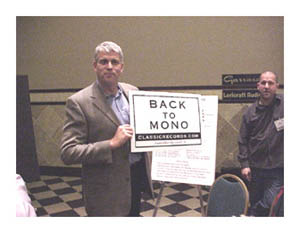
Press Conference! There was an audible gasp from the crowd
when Mike Hobson of Classic Records (www.classicrecords.com)
announced their new Blue Note Mono Series of LPs. Many highly sought after titles that
command hundreds of dollars as mint originals will be released. This project has been more
than a year in development, solving problems such as what to do about the lack of a groove
guard on the originals. Classic really did this right when they decided to bite the bullet
and restore a Westrex mono cutting system with a 2A cutting head and a mono Ampex 300 tape
deck. The impetus for all of this is the fact that they compared the results of test
pressings from stereo and mono cutting systems, and found that the results from the mono
system were "spot on." Their first release is an album by Miles Davis as a young
man. Friends who went up to the Immedia room to hear the playback after the press
conference uniformly raved about the sound. Classic will also be doing a Vanguard
Classical series from the original tapes. It’s great to see that we can look forward
to more classical releases from Classic in the near future. Kudos to Mike Hobson, Coleman
Brice, Neal Jones, and the rest of the team from Classic.
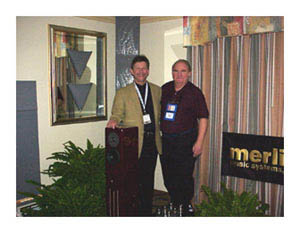
The Best Sound in the Show was from Merlin Music
Systems (www.merlinmusic.com). The ever-gracious
Bobby Palkovic demonstrated the Merlin VSM Millennium loudspeakers, ably powered by Joule
Electra tubed electronics from Jud Barber. This system had a combination of aliveness and
dynamics, coupled with delicacy, transparency, and definition that I found absolutely
captivating. The massed choir on the Proprius Cantate Domino was exquisite, with
the business end of the room replaced by a gorgeous rendition of real singers in a real
space. The choir on Winston Ma’s Hush, The Angels are Singing was reproduced
with beautiful articulation and dynamic expansion. And the high-energy jazz on track 4 of
John Marks’ Harry Allen Quartet: Blue Skies was fleshed out better than on any
other system in the show. And that wasn’t all. During a return visit, Bobby brought
out Radiohead's Amnesiac CD. The low bass on track 1, played through the VSMs,
launched discrete acoustic blobs at various parts of my body that impacted with tactile
puffs of air. This engendered glee from Stan and me. Even after eighteen CES shows, new
experiences can be had. Kudos to you, Bobby, for a great system, and thanks once again for
your always-generous hospitality. Associated equipment was a VPI TNT turntable, a Cardas
Heart phono cartridge, and an Audio Aero CD player.
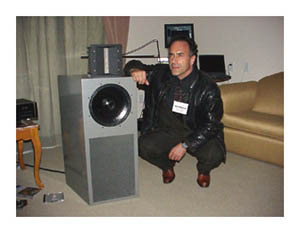
The system with the Best Spectral Balance was from ORCA
Design & Manufacturing Corp. (www.orcadesign.com),
run by Kimon Bellas. ORCA manufactures the venerated Raven ribbon tweeter in California,
and they import drivers from French companies such as Focal, Cabasse, and PHL. The
loudspeakers at the show used the Raven 3.0 tweeter, a PHL 12" cone for the midrange,
and a PHL rear-firing 18" cone for the bass, with the Raven crossed over at 750Hz. I
was immediately struck by the purity of tone and the utter rightness of the spectral
balance on my favorite choral recordings. The reproduction on this system was clean,
natural, and transparent. The speaker system was voiced by Pat O’Brien of W.A.R.
Audio in Perth, Western Australia (011-61-8-9242-5538 from the U.S.), who did a truly
outstanding job. The Bel Canto Evo 4 digital switching amp, which uses PDM (Pulse Density
Modulation) technology, was driving the speakers. This system was a Stan and Dave fave.

The Most Stunning Electronics, producing one of the
very best sounds in the show, were from the Hovland Company (www.hovlandcompany.com). Jeff Tonkin, a former
professional architect of great taste, is responsible for the appearance of the highly
regarded HP100 preamp and the drop-dead-gorgeous Sapphire amp. The Sapphire is a hybrid
(solid state input/tubed output) push-pull design, and two were being used in bridged (80
W) mode to run a pair of Audio Physic Avanti 3 speakers. This system sounded natural and
relaxed, with outstanding timbre and articulation, but also with excellent transient
response. It’s the kind of system that you can sit and listen to all day. Track 1 of Sonny
Boy Williamson: Keep it to Ourselves sounded so natural that it was almost literally
scary. This year, Bob Hovland and Mike Garges had to stay home to oversee production to
meet the high demand for the HP100 and the Sapphire, but Jeff and Alex Crespi put on an
excellent show. Hovland was one of very few systems that really stood up during my
end-of-show pass through the candidates for best-sounding rooms. It was a true pleasure,
guys. Associated equipment included a G&D Transforms CD player and an Immedia RPM
turntable. (I should also note that Hovland’s highly regarded Music Groove tonearm
cable is everything that the reviews say it is. This cable, firmly ensconced in my
reference system for years, has helped to make my vinyl listening a consistently rewarding
and thoroughly enjoyable experience. Many thanks to Mike Garges for the opportunity to
hear the latest incarnation of a tonearm cable that just seems to keep on getting better
as new versions are developed.)
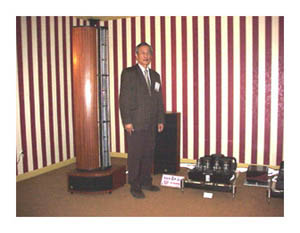
(Pictured is Robert Lee of Acoustic Zen) The Best New Large
Speaker from Impact Technology Ltd. (www.membrane.com/impact)
Upon first seeing the Airfoil 5.2 loudspeaker, I immediately was reminded of the Linnaeum
driver. It turns out that Paul Paddock, the designer of the Linnaeum driver, also designed
the "bending wave transducer" for the Impact. This speaker is a beautifully
crafted line source tower, covering 170 Hz and up, resting on a woofer enclosure. This
system was being demonstrated in one of the largest rooms in the show, and had excellent
transparency, neutrality, inner detail, and delicacy, coupled with great bass and a
stunning soundstage. This system produced one of the best sounds in the show, and it was
one of the very few that stood up to my end-of-show second pass after everything else was
put into perspective. Contributing to the outstanding sound in this room were cables from
Robert Lee of Acoustic Zen Technologies (www.AcousticZen.com),
who from long ago I have come to know as one of the most dedicated and discerning
practitioners of the audio arts I have ever had the pleasure to meet. Associated
equipment: BAT (Balanced Audio Technologies) CD player, preamp, and VK-150SE amps.
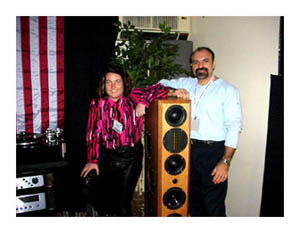
The Best Merger of Audiophile and Pro-Audio Sensibilities was much in evidence at
Manley Laboratories (www.manleylabs.com). The ever
upbeat and take-no-prisoners EveAnna Manley was showing off the highly acclaimed Manley
Steelhead phono preamp, which has an incredible array of useful features right on the
front panel, and the usual high build quality. EveAnna was also featuring an upgraded Wave
Preamp/DAC (with a new 24/96 board), and the new Snapper 100 W monoblock. These were
powering a pair of Coincident Total Victory loudspeakers from Israel Blume (www.coincidentspeaker.com). (Hey, the solar
astronomer here... me... wants to know what happened to the Total Eclipse speakers from
last year. Have they been overshadowed by a newer model?) There were many, many other
Manley products on static display, including the new entry-level Shrimp preamp, along with
veritable heaps of vacuum tubes that looked like they were recovering from a big party the
previous night. The sound of this system was thoroughly enjoyable, relaxed, musical,
dynamic, and F*U*N. The LP reproduction was phenomenal. The CD reproduction really floated
my boat as well. It was one of the very few rooms where I just wanted to sit and listen.
My hat’s off to EveAnna (not that she ever takes hers off) for taking the helm of
this company and running with it.
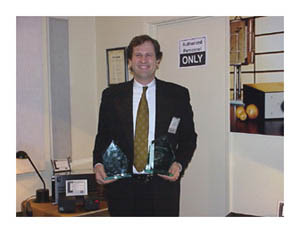
The Best High-Power Tube Amps were in the Vacuum Tube
Logic (VTL) room (www.vtl.com). Luke Manley was
featuring the MB-750 monoblock, a monster of a double-decker amp that uses twelve 6550s
per side. That’s twice the tube complement in my beloved VTL Deluxe 300s. The MB-750
puts out 750 W in tetrode mode, and 350 W when switched to triode mode (which is done with
the flick of a switch). Luke was also featuring the new TL7.5 Reference preamp, a two-box
fully balanced design that is designed to be the matching front end for the MB-750 and its
big brother, the Wotan MB-1250. Running a pair of Wilson Watt/Puppy loudspeakers, the
sound was magnificent and effortless, with quite real reproduction of the lower organ
pedals coupled with delicate choral voices. VTLs are just about the only tube amp that
will make my Eminent Technology LFT-8s really stand up and sing (many thanks to Ted
Conger!), and I am quite enamored of them.
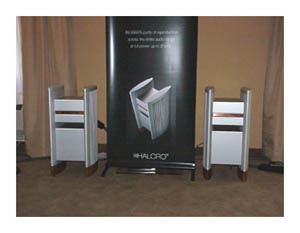
The Most Refined Sound in the show, and one of the very
best sounds, was in the Halcro room (www.halcro.com).
This Australian company builds highly regarded solid state preamps and power amps, and
this year I found out why. Philip O’Hanlon (the US distributor) was demonstrating the
Halcro dm10 preamp and dm58 monoblock amps, powering Wilson Audio Maxx loudspeakers. He
was playing some gorgeous Nagra master tapes kindly loaned by Peter McGrath. This system
sounded utterly clean, natural, and effortless, with a delicacy and reproduction of tiny
inner details that was bordering on mesmerizing. It was obvious from literally the first
note that this system was qualitatively different, and a cut above, almost everything else
at the show. The sound of this system was astoundingly clean, but that cleanliness was
coupled with outstanding authority. These amps, designed in South Australia by Bruce
Candy, appear to be a tour de force.
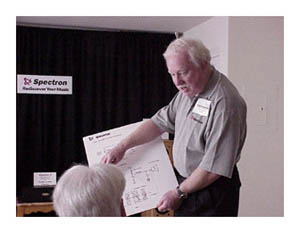
The Most Cutting-Edge Solid State Amplifier was being
shown by John Ulrick of Spectron (www.spectronav.com).
John designs and manufactures Class D digital switching amps that operate on the principle
of Pulse Width Modulation (PWM). The 125 wpc Troubador stereo amp weighs only 12 lbs, but
is no musical lightweight. Powering a pair of Von Schweikert VR-5 HSE loudspeakers, this
all-digital amp was utterly clean and musical, with fantastic peak-handling ability. John
had a nice, succinct explanation of the operating principles of his amplifiers, all on a
single poster. Positive Feedbacks’ digital guru Mike Pappas has gone
full-scale gaga over these amps. I was intrigued enough by this technology to ask to hear
one in my own system. Kudos to you, John, for your pioneering efforts to bring a new
technology into high-end audio.
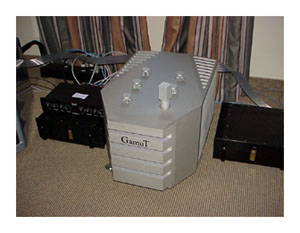
The Most Awe-Inspiring Solid State Amplifier was from
GamuT ApS (www.gamutaudio.com) of Denmark. Their
gracious designer, Ole Christensen, greeted me as if I were an old friend, and proved to
be a sheer joy to talk to. A system comprised of the GamuT CD-1 CD player, C-2R preamp,
D-200 power amp, and GamuT Phono Stage, running a pair of Magnepan 3.6 loudspeakers,
produced one of the best sounds in the show, with outstanding timbre and reproduction of a
real choir in a real space. I was also really struck by the build quality of these units.
Their faceplates were polished brass overlaid by polished nickel overlaid by polished
chrome, and were visually stunning. But the real showstopper was the new Gamut S300 stereo
amplifier. This 401-lb. brute sports twenty Rifa 20,000 �F capacitors, and four 10-inch
diameter 2500 W toroidal transformers. This thing can double as a step stool or as an
extra seat for a visitor, as gleefully demonstrated by Ole. But the thing that really got
my attention is that this beast has only a single (MOSFET) output device per side. As Ole
puts it, the amp sings with a single voice, rather than with many that slightly differ.
The sound, as you might guess, was authoritative and clean. A full assessment was
precluded due to the small room size.
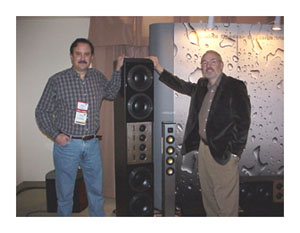
(Pictured is Dave Glackin and Frank Hale) The Best New
Desktop System was from Frank Hale and Jannie Tsui of Swans Speaker Systems (www.swanspeaker.com). Frank is the original owner of
Swans, and it was a treat to see him brought back as a technical consultant by the
perspicacious new owners of the company. The self-powered desktop system consists of two
small satellites and a woofer module, and it retains the gorgeous appearance of the
classic Swans loudspeakers. But what really grabbed me was the sound quality. This little
system sounded better than many of the big systems in the show on my reference Cantate
Domino CD, with soloists, choir, and organ all sounding quite good. The appearance and
sound quality of this little system belie its list price of $200. Frank, it’s very
nice to see you back!
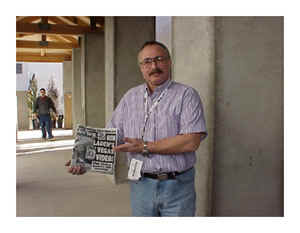
The Best Clues to the Mysteries of the Universe were offered by Ric Cummins of
Rosinante and Argent Audio. Ric has annually been transporting large quantities of the
proprietary and mysterious DarkMatter from Eudora, Kansa, to Las Vegas, Nevada.
Astronomers have now linked this oscillation in space and time to a heretofore-unexplained
perturbation in our local arm of the Milky Way galaxy. This mystery has greatly perplexed
astronomers who have been struggling to interpret data from the Hubble Space Telescope,
but after eliminating all other possible explanations, they have now concluded that it
must be due to Ric. His smiling face will soon appear on the cover of the Astrophysical
Journal as an example of an A-number-one troublemaker. Nice going, Ric. (I’d hate
to see what havoc you could wreak with a little DarkEnergy in your arsenal.) What the heck
does this have to do with audio, you ask? As it turns out, not much, and if that bothers
you, go read something else. But just a minute, maybe there is a connection after all....
Ric’s Dulcinea speakers, exhibited at the show for the second
time, are awash in DarkMatter. Heck, the whole baffle board is made with the stuff. And
when used in audio, instead of to perplex poor astronomers, DarkMatter really shows off
its positive qualities. Ric’s system was sounding smooth, musical, transparent, and
authoritative, with an expansive soundstage. His efforts really show, as it sounded the
best that it ever has. Ric’s Sancho powered subwoofer was handling the frequencies
below 40 Hz, and is said to be flat to 18 Hz. Also aiding the sound were several Argent
RoomLens room treatment devices (Helmholtz resonators that are quite effective at taming
room acoustics). Check out www.roomlens.com, if you dare. Associated equipment: Gill tubed
preamp and tubed DAC (both available with remote) and an Art Audio Jota 13 W tubed amp.
Ric was in fine form, throwing a great quip off the top of his head when he opined that:
"Karma is merely random revenge without the satisfaction."
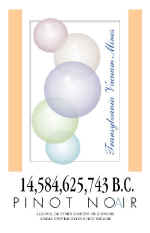
The Most Effective Use of Primordial Vacuum was by Keith Herron of Herron Audio (www.herronaudio.com). Keith has succeeded where all
others have failed, and has uncovered a source of nearly fifteen-billion-year-old vacuum,
deep under Transylvania, which product he has cleverly dubbed Pinot Noair, containing only
"single crystal oxygen free vacuum." Keith noted "theory has it that this
was the pure stuff that flooded the universe in the instant (at minus-one chronon, the
smallest particle of time) before the big bang." Now let’s see. That means that
in the infinitesimally small instant before that, the universe underwent... the big suck.
Or not. Sadly, Keith noted that his far-flung expeditionary forces had originally
discovered two mines, the one under the Himalayas producing prodigious vacuum until it
imploded, thus necessitating the arduous move to Transylvania. From this mountainous
region, they transport the primordial vacuum on railcars, frozen into a relatively safe
wet state, referred to as Liquid Vac. But with the recent slowdown in the market, Keith
noted that he has, sadly, been forced to store large quantities of vacuum underground near
his facilities in St. Louis. So watch your step.
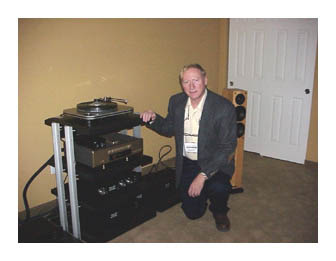 And how does this primordial vacuum sound when it’s injected into little
glass bottles? Pretty cosmic. Keith’s tubed electronics were being used with an
Immedia turntable, the soon-to-be-available Audio Physic solid state amps, and the Audio
Physic Avanti III loudspeakers. The sound was effortless, with great delicacy, and a
gorgeous soundstage that floated in the room. This Herron/Immedia/Audio Physic system
created one of the best sounds in the show. In an adjoining smaller room, the Herron
VTSP-1A preamp, VTPH-1 phono preamp, and M150 power amps were running a pair of the small
new Audio Physic Yara loudspeakers, with an Immedia turntable (www.immediasound.com/AudioPhysic.html)
and Helikon cartridge providing the input. The sound had a delicacy, subtlety, nuance, and
tonal purity that was captivating. This was one of the small handful of rooms in which I
just wanted to sit and listen. Keith’s impeccable musical sensibilities always seem
to have that effect on me. And needless to say, Keith took Best Quip of the show.
Work on it, Ric. And how does this primordial vacuum sound when it’s injected into little
glass bottles? Pretty cosmic. Keith’s tubed electronics were being used with an
Immedia turntable, the soon-to-be-available Audio Physic solid state amps, and the Audio
Physic Avanti III loudspeakers. The sound was effortless, with great delicacy, and a
gorgeous soundstage that floated in the room. This Herron/Immedia/Audio Physic system
created one of the best sounds in the show. In an adjoining smaller room, the Herron
VTSP-1A preamp, VTPH-1 phono preamp, and M150 power amps were running a pair of the small
new Audio Physic Yara loudspeakers, with an Immedia turntable (www.immediasound.com/AudioPhysic.html)
and Helikon cartridge providing the input. The sound had a delicacy, subtlety, nuance, and
tonal purity that was captivating. This was one of the small handful of rooms in which I
just wanted to sit and listen. Keith’s impeccable musical sensibilities always seem
to have that effect on me. And needless to say, Keith took Best Quip of the show.
Work on it, Ric.
The Best New Small Dynamic Speaker was the Audio Physic Yara,
as heard in the Herron/Immedia room (above). This looks like a real bargain for $1495 list
price.
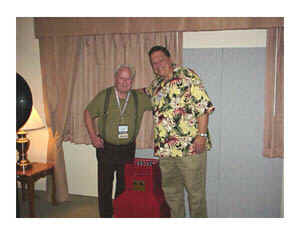
(Pictured is Stan Ricker and Mike Maduras) The Best Use of Carbon Fiber in high end
audio goes, hands down, to D.J. Casser of Black Diamond Racing (www.blackdiamondusa.com) and Mike Maduras ([email protected]) of the Glass Amplifier Company. Mike
was showcasing his new, much more cost-effective amp, the PL509SE.1. It may not have a
fancy faceplate, and it may use a tube that most folks never heard of (the 40KG6), but
this 17 wpc SET amp sure sounded nice! Last year I reported that my experience in this
room was the only time that I have liked the Avantgarde horn loudspeakers. That experience
was repeated this year. Stan spent a long time in this room, being quite drawn in by the
sound, and having a blast with his Swedish Jazz Kings CD. I should also note that
DJ’s shelves, pucks and cones are used throughout my reference system, and they are
really helping my system to sing in top form.
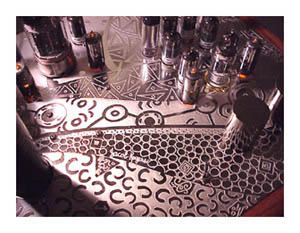
The Best Application of Art to Audio was Emotive Audio (www.emotiveaudio.com), hands-down. Shown in the
S.A.P. (Strumenti Acustici di Precisione) room, the Sira preamp had a stunning etched
metal top plate, signed by the artist, Jacob Rogers. This must be seen to be believed.
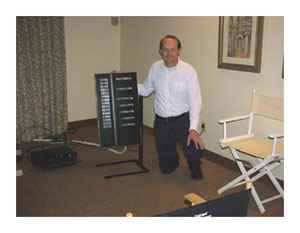
The Best Small Planar Speaker was from Eminent Technology (www.eminent-tech.com) and the ever gracious and
understated Bruce Thigpen. Bruce’s small LFT-142, which has been in development for
several years, is now in production, and it was sounding quite good at the show. This new
small panel represents an evolutionary version of the Eminent Technology LFT-8 push-pull
magnetostat. That speaker has resided happily in my reference system for many years now,
standing up against all contenders. The LFT-142 creates very nice bass for such a small
panel, which led Stan to wonder where the subwoofer was, which led Bruce into a long
technical discussion of their innovative construction. Ultimately, Bruce plans to use the
small panels as the building blocks for a new large system, which I can’t wait to
hear. Bruce also makes a very nice small planar speaker for use as computer monitors. It
was a pleasure to see you as always, Bruce.
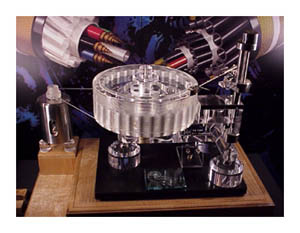
The Most Stunning Turntable was exhibited by George Cardas of Cardas Audio (www.cardas.com). The SpJ La Luce turntable is a true work
of art. On a more personal note, George’s contributions to audio, his dedication, and
his concern for the well being of others in the field are becoming legendary. One
particular act of his a year ago that I am privy to left me practically speechless. My hat
is off to you, to say the least. I should also note that George’s interconnect and
speaker cables have been making my reference system sing in top form for many years.
The ReTHM/Diva room was sounding great, producing one of the best
sounds in the show (except for some unfortunate voice-coil rubbing in the Lowther
drivers). The ReTHM speakers (www.rethm.com), being
demonstrated by Jacob George, and the Diva tubed electronics, from T. S. Lim (www.divaaudio.com), combined to create gorgeous
timbre, great spaciousness, and naturalness, with excellent peak-handling ability. We
heard the 25-wpc Diva Tian Zhu amplifier, a parallel single-ended design, with EL34s being
driven by 2A3s (how’s that for something different?).
The deHavilland (www.dehavillandhifi.com)
and Buggtussel (www.buggtussel.com) system
produced a sound that was alive and dynamic, yet delicate, with a great sense of a real
choir in space, and excellent low bass reproduction of the organ on Cantate Domino.
A pair of Buggtussel Lemniscus loudspeakers was being driven by a pair of deHavilland
GM-70 SE triode amps. These are unusual amps, in that the 300B sitting up front isn’t
the output tube, it’s the driver for the output tube, which is a Ulyanov GM-70. An
unusual setup, but the results speak for themselves. I should also note that Kevin Blair
of Buggtussel manufactures a very interesting record cleaning solution called Vinyl-Zyme
Gold, which contains an enzyme that biologically munches all of the bad gunk in your
grooves. An interesting, different, and reportedly very effective product.
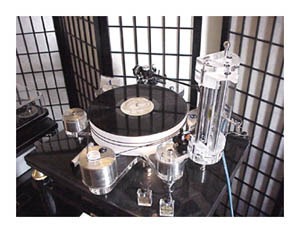
The Most Stunning Turntable (Runner Up) was the Clearaudio Maximum Solution. It can
accommodate up to three tonearms, and has a power generator that resynchronizes the power
to the three motors. (www.musicalsurroundings.com)
The Best Demo of the Advantage of more than Two Channels
was in the Gradient (www.gradient.fi) van den Hul (www.vandenhul.com) room. Ever since hearing a
demonstration of what 5.1 channel sound can do for full orchestral recordings, at the home
of none other than Gordon Holt, I have been convinced that something is missing with
two-channel sound. And I’m not talking about egregious sound effects crapola that
would have you perched right between the oboe and the bassoon. I’m talking about the
realism that is added in terms of acoustics and hall sound to well-recorded source
material. While in this room, I had a most enjoyable discussion with former journalist A.
J. van den Hul about journalistic ethics, and we found ourselves to be in complete
agreement. A most refreshing discussion.

Vince Bruzzese of Totem Acoustic (www.totemacoustic.com)
manufactures what is, in my opinion, one of the consistently great lines of loudspeakers.
This year, he was demonstrating the Totem Wind loudspeakers, powered by electronics from
Myryad, and they were sounding as beautiful and holographic as always. Totem has more
recently expanded into in-wall and home theater systems, and the Dreamcatcher 5.1 system
was sounding excellent.
Lionel Goodfield of SimAudio (www.simaudio.com)
was demonstrating his Moon line of electronics: the Eclipse CD player, the P5 preamp, and
the Moon Rock (get it?) monoblocks, with fully balanced differential circuitry. This is a
real beast of an amplifier. Powering Merlin VSM Millennium loudspeakers, the sound was
spacious, with excellent bass.
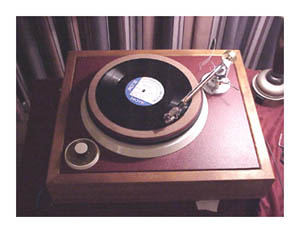
The Best Classic Turntable was the Garrard 501 from Loricraft Audio of England (www.garrard501.com). Loricraft have acquired sole
rights to the Garrard name from the Brazilian company that owned them, and their factory
is close to the site of the original Garrard factory. Terry O’Sullivan demonstrated
the 501, the "first new high-end Garrard turntable in 25 years," and the Missing
Link phono stage, in the Kondo/Audio Note room. Martina Schoner of Loricraft and Scan-Tech
Europa discussed some of the company’s ambitious future plans. The sound of the
system was gorgeous, and as loyal readers of Positive Feedback know, the turntable
is a winner.
The Prettiest OTL Amps were in the Tenor/Rockport room (www.tenoraudio.com). Robert LaMarre and Francois
Lemay were showcasing the drop-dead-gorgeous 75 wpc OTL monoblock amp. They were powering
a pair of the enormous Rockport Hyperion loudspeakers, which, in this reviewer’s
opinion, did not do the amplifiers justice, because I know how good they can sound. This
company has ambitious plans, and I have always been quite enamored of their products, and
impressed by the high-tech nature of their plans.
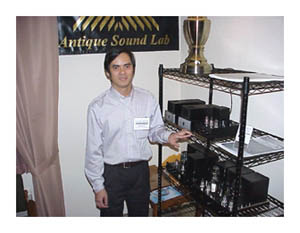
The Best Headphone Amp in the show was from Antique Sound Lab (www.divertech.com). I had an informative discussion
with Joseph Lau Tze Wah, the designer of Antique Sound Lab’s equipment. The new Twin
Head headphone amp, which uses 2A3 tubes, has two outputs: with a transformer in the
signal path, or OTL. The pre-production prototype that I heard sounded quite impressive,
and it will drive the low-impedance Grados as well as my fave Sennheisers.
The Best Modern Interpretation of a Classic Speaker was in
the Quad room (www.quad-hifi.com). The new Quad 989
has a kind of ultimate purity of tone that is attention grabbing, probably matched only by
the Raven tweeter in the ORCA room. I’ve always wanted to hear a pair of Quads in my
own room, and my experience at the show this year may finally get me off my audio butt to
make that happen.
The Best Grit and Determination (Permanent Award on the Mantel) goes
to Barry Kohan of Bright Star Audio (www.brightstaraudio.com).
Barry’s well-known line of vibration control products is used in many applications
throughout the industry now, and they were scattered profusely throughout the show. Barry
was showcasing his more cost-effective products this year, the improved Air Mass 3 ($99)
and improved Air Mass DVD ($149), as well as the mind-bogglingly inexpensive IsoNode feet.
Barry has suffered tremendous personal adversity over more than the last year, and it was
a real relief to see him fully recovered. His attitude has been a serious inspiration.
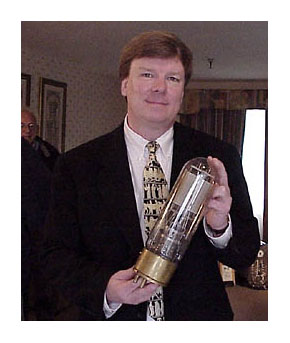
The Best Reborn Tube Company is the Westrex division of Western Electric. While
this company is not exactly new news, Charles Whitener continues to lead an organization
that makes what are generally recognized as the best sounding 300Bs around. Soon, the
WE274B, a full-wave rectifier, will become available. Newly manufactured Genalex Gold Lion
KT88s are also due to become available in 2002. Finally, the company has plans to produce
the 212E, one honking big audio tube at 13 and 5/8 inches high. You can take an
interesting tour of the Kansas City factory at www.westernelectric.com.
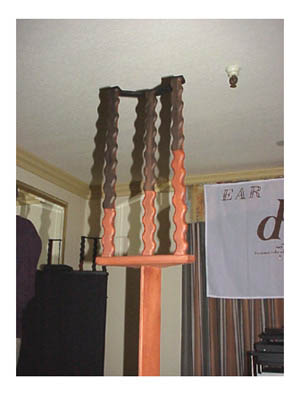
The Best New Room Treatment at the show was by Ben Piazza of Shakti. This was
demonstrated in the E.A.R. room. The Hallograph Soundfield Optimizer is a tall
floor-standing wooden device designed to work in the room corners behind the speakers. On
top of a wooden post are four vertical wavy wooden segments, made out of two different
kinds of wood, each containing a resonant chamber. They are difficult to describe in
words, but they did work. With the devices in place, the soundstage filled out and the
midrange and treble sounded more natural. With the devices removed, there was reduced
ambience and naturalness to the sound. Go to www.shakti-innovations.com
to learn about the audio (and automotive) products from this company.
The E.A.R. (www.ear-usa.com)
room was sounding great, with electronics by Tim De Paravicini driving Quad 989s. The
E.A.R. 312 preamp and M100A monoblock amps were powering a system that sounded
holographic, with great articulation and transparency.
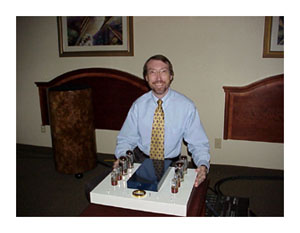
The VAC (Valve Amplification Company) room (www.vac-amps.com)
of Kevin Hayes was sounding tasty, with the new VAC Virtu amp powering a pair of the
towering Pipedream loudspeakers (www.nearfieldacoustics.com). This was the best sound I
have ever heard from these speakers.
The Best Depth of Image in the show was attained by Randy
Bankert from O.S. Services (www.ossaudio.com). Randy
is a distributor of audio equipment from around the world. He was demonstrating an
impressive array of electronics from Cadence Audio and Audion, and hybrid horn/cone
loudspeakers from the Italian company Zingali. The Zingali horn midranges are crafted from
solid blocks of poplar, using a proprietary exponential horn design with a rapid flare
rate. The tulip wood cabinets were beautiful, as befits anything Italian. We heard the
Cadence Audio Canasya 845-based amps (50 W Class A, 200 W Class A/B) and the Audion
Premiere 1.0 remote control preamp with the Zingali Overture 3S loudspeaker. This system
produced startling depth of image, outstanding image definition, and immediacy. And the
room treatment? None, other than the bedspread provided by the Tuscany. Bravo.

The Best Lamp of the show reared its pretty head in the GamuT room. Darrin and Gene
O’Neill of Audiolimits (www.audiolimits.com)
were displaying a stunner of a lamp created partly from a big old Western Electric 861
tube, whose filaments were glowing brightly. These aren’t inexpensive devices, but
are perfect for the audiophile who thought (s)he had everything. I want one.
The Best CD Treatment in the show was from
Toy Shigekawa of Torumat. Toy’s fluid has been an essential part of my reference
system for years, and his latest CDX-16-3 is his best yet. I also use his Torumat TM-7
fluid in my Nitty Gritty to clean LPs. It helps when you have someone with a degree in
physical chemistry making this stuff. Toy also manufactures turntable mats and pucks,
which have received very favorable reviews, and I hope to audition a set on my VPI TNT
shortly. Contact Toy at [email protected].
Jan Jurco from J J Electronic, manufacturers of tubes and some
gorgeous tubed electronics from Slovakia, were playing their JJ 243 preamp and JJ 322 amp
(single-ended with 300Bs) into Reference 3A loudspeakers, a high-efficiency favorite. The
sound was warm, natural, and seductive, lacking only in the low bass. Check out their
electronics, and their wide variety of tubes, at www.jj-electronic.sk.
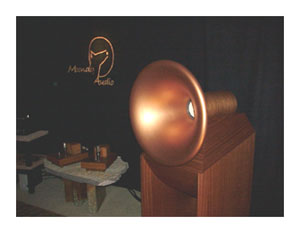
The Best Visual Setup at the show this year was by Ron Welborne of Moondog
Audio (www.moondogaudio.com), which is a new arm
of Welborne Labs. Ron was showing his Oris horns from Europe (106 dB efficiency with
Lowther drivers), sitting on top of bass cabinets using Cabasse drivers. They were being
powered by the Moondog 2A3 monoblocks (3.5 wpc).
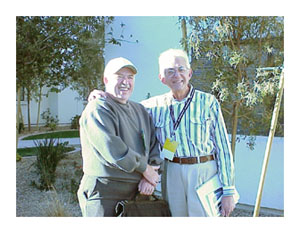
The Best Manufacturers Missing in Action from the show
were D. J. Casser of Black Diamond Racing, Dr. Bruce Edgar of Edgarhorn, and Cy
Brenneman of Cyrus Brenneman Audio. They all seemed to have excellent excuses, but I
don’t plan to cut them so much slack next year. Bruce Edgar is shown here with my old
friend Saul Sokolsky, who runs The Audio Enthusiast, a high-end audio dealership in
Palos Verdes, California. I am indebted to Saul for many things, most recently for
introducing me to David Platus’ phenomenal prototype platform, a review of which
appears elsewhere in these pages.
The Best Editor Missing From the Show was David Robinson.
Stuck in Portland was he, poor guy. A lot of folks were asking after you, David. Hope you
make it next year.
The Best Dealer Missing From the Show was Brooks Berdan of
Brooks Berdan Ltd. in Monrovia, California. Brooks is an internationally recognized
turntable guru, analog maven, and source of excellent advice and support. My system
wouldn’t be what it is without him. Brooks can be contacted at 626-359-9131.
The Manufacturer I’m Most Sorry to have Missed is Status
Acoustics (www.statusacoustics.com). Twice in
past years, I have awarded designer Shane Rich and company founder Roger B. Hassing
best sound in show, for a loudspeaker that Stan Ricker and I both thought just did
everything right. My only excuse is that they were only showing at the Convention Center,
and there was simply too much to see where I was. My humblest apologies, gentlemen. This
is a company that deserves major recognition.
The Best Breakfast at the show was graciously provided by
Steve Rochlin, editor, publisher, and chief web grunt at EnjoyTheMusic.com. It was
nice to be able to meet some of my fellow writers, whose ranks seem to be growing rapidly.
And the tux was a nice touch, Steve (although I kinda missed the moose slippers).
The Best Evening Social at the show was kindly provided by
Coleman Brice, Neal Jones, Troy San Thompson, and their chief, Michael Hobson. It is
always a distinct pleasure to deal with Colie Brice, an outstanding individual who is
doing an exceptional job as Director of Marketing for Classic. We also had a fascinating
conversation with Neal Jones, their Director of Production, about all of the things that
go into the record jackets that most people would never even notice. I’ll look at
Classic’s LP jackets with more insight from now on. Thanks for the great evening,
guys!

The Best Live Music in the show? I heard two good choices. The first was a concert
by Crosby, Stills and Nash put on by Monster Cable as part of their annual awards dinner.
Although the sound reinforcement was excruciatingly bad in the Grand Ballroom of the
Mirage, and these fellows’ voices aren’t what they were in the sixties, it was
great to see them perform a lot of their old hits. The highlight of the evening had to be
Stephen Stills’ guitar playing. He remains a real virtuoso (even if he did stick to
electric guitar... where was the acoustic, man?). Many thanks to Noel Lee of Monster Cable
for the invitation.
The second choice for Best Live Music was a concert by The
Persuasions, made possible by David and Norman Chesky of Chesky Records (www.chesky.com). This a cappella group has been
around for four decades. They performed at the CES party on Tuesday evening, and sang
Beatles songs, mostly from Abbey Road, using nothing but their voices for both
instrumentals and voice. This has got to be a real challenge, but they were innovative,
polished, and witty, and they really held the audience’s attention. Kudos to Chesky
for having the imagination to record this group, and for having the generosity to make it
possible for us to hear them live.
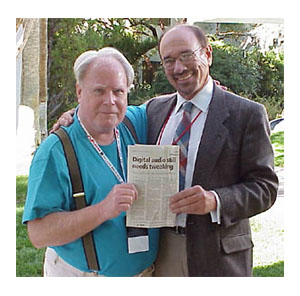
The Most Collegial Fellow Writers in the show were Clark Johnsen of Positive
Feedback and EnjoyTheMusic.com (great minds think alike), and Bob O’Neill
of Bound for Sound. Stan and I enjoyed our evening at the Holy Cow. Clark knows his
brews, cold.
The Best Audio Buddy in the show was mastering and musical
maven Stan Ricker. Stan and I have done the show together for several years now. This
year, I thought that if I’d had a tape recorder running during all of our
conversations over the years on the way to and from CES, in the hotel room, at dinner,
etc., that I could write another 45-page interview with Stan that readers would enjoy as
much as the original one in Positive Feedback. (FYI, that article reappears on EnjoyTheMusic.com.
Click on "Review Magazine," then on "Archives," then on "Factory
Tours and Interviews," then on "Stan Ricker." Curl up in your easy chair
with your laptop, and enjoy the story of one of the few true renaissance men of the audio
and music world.
Upcoming Music Reviews
Here’s some of what will be spinning in my listening room soon.
The following folks have kindly given me LPs, CDs, and now SACDs to review. You’ll be
reading about these in the future. Chad Kassem of Acoustic Sounds (www.analogueproductions.com) sent SACDs of
Wild Child Butler and Harry Hypolite, as well as 45 rpm LPs of Henry Gray and Pinetop
Perkins some time ago, which have yet to be reviewed due to home remodeling. I’ll
have the listening room back soon, Chad!
Mike Hobson and Coleman Brice of Classic Records (www.classicrecords.com) supplied the first of
their mono Blue Note recordings (Miles Davis) and a new Sarah Vaughan LP.
Joe Harley of JVC XRCD (www.xrcd.com)
fame supplied new CDs of Kenny Burrell, West Side Story, and Henry Mancini.
Winston Ma of First Impression Music (www.fimpression.com) supplied a new CD entitled Autumn
in Seattle, plus three new SACD titles.
John Wood of the newly reborn Mobile Fidelity (www.mofi.com) supplied an SACD of Patricia Barber.
David Chesky of Chesky Records (www.chesky.com)
supplied a new CD of The Persuasions singing Beatles songs a cappella (see
description of concert above).
Mark Waldrep of AIX Records (www.aixrecords.com),
a new company, supplied a DVD Audio/Video sampler that has two sides. The DVD-A side
contains brand new recordings done with 24 bits/96 kHz mixed to 5.1 channels. The DVD-V
side contains the video of those performances, along with stereo and Dolby Digital audio
mixed to 5.1 channels. I’ll have to find a willing friend with a great home theater
system on which to try this out fully.
Robert Pincus of Cisco Records (www.ciscomusic.com)
provided new LPs of music by Prokofiev and Mozart. These LPs represent a new departure for
Cisco, who are now producing their own 180-gram LPs in the US, mastered at AcousTech
Mastering, and pressed at RTI (Record Technology, Inc.).
Finally, a brand new label called Pure Audiophile ([email protected]), started by Dennis Cassidy in Kansas
City, Missouri, has released their first LP. It is a new interpretation of a classic album
by my favorite saxophonist. Entitled Ballads: Remembering John Coltrane, by Karrin
Allyson, it was originally released on Concord. This 2-LP set, half-speed mastered by Stan
Ricker, is available on 180 gram blue vinyl, pressed at RTI. The blue vinyl requires
special pressing and quality control techniques. Karrin Allyson was nominated for a Grammy
for this performance.
The Reference System
For new readers, so you know where I’m coming from, the
following is a description of the system used in the post-show reviews. LPs are played on
a VPI TNT with a 10" JMW Memorial arm, a Benz Ruby cartridge, and a Black Diamond
Racing (BDR) record clamp. The turntable rests on a BDR "The Shelf for the
Source." (My Bright Star Big Foot TNT will be added back to the stack before too
long.) This all rests on a VPI TNT stand filled with 200 lbs of lead shot, spiked to a
reinforced floor.
A Hovland Music Groove tonearm cable takes the signal to a Klyne
SK-2A headamp, then Cardas Cross takes it to a Music Reference RM-5 tubed preamp. Cardas
Golden Cross takes the signal to a pair of Vacuum Tube Logic (VTL) Deluxe 300 tubed
monoblocks, outfitted with 6550 WE Sovtek tubes. Biwired Cardas Golden Cross speaker
cables connect the amps to Eminent Technology Model 8 loudspeakers, which themselves are
Cardas-wired and mounted on Sound Anchor stands.
The equipment before the power amp is isolated in a walk-in closet,
while the amp and speakers are in a dedicated listening room treated with RPG Diffusers,
Room Tunes, ASC Tube Traps, and a big Navajo rug. Everything except the power amp is
plugged into two Audio Power Industries Power Wedges. A Philips CD680 CD player is used as
a transport, connected to a Theta Cobalt DAC via Cardas Microtwin, while Cardas Cross is
used from there to the RM-5. The DAC uses a Hovland power cord. The electronics in the
closet are on a Target B5 stand.
The headamp, preamp, amp, CD transport, DAC, and TNT power supply
are isolated with various combinations of BDR Pyramid Cones, Pucks, and Shelves. Open-
reel tapes can be played via a Technics RS 1500 semi-pro 2-track 15 ips tape deck, the one
with the big U-shaped transport (a really good machine which is used as a transport by
Chesky in their analog mastering). CDs are treated with Torumat CDX-16-3. LPs are cleaned
on a Nitty Gritty 2.5 Fi using Torumat TM-7XH. A Hunt EDA Mark 6 record brush, the best I
know, is used for dry cleaning of LPs. Headphone listening can be done with an EarMax
tubed triode headphone amp and a pair of Sennheiser HD-580s.
And as we go off into the sunset... until next year!

|


